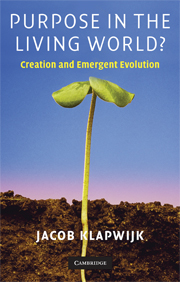Book contents
- Frontmatter
- Contents
- List of figures
- Preface
- Introduction
- 1 Does life on earth have a purpose?
- 2 Creationism, Intelligent Design, and Augustine's idea of time
- 3 Darwin, neo-Darwinism, and the naturalistic continuity claim
- 4 Miller's pre-biotic broth and the premises of evolutionism
- 5 A cold shudder along Darwin's back
- 6 The emergence theory of Morgan and Alexander
- 7 Luctor et emergo: what is emergent evolution?
- 8 Toward a general theory of emergent evolution
- 9 Hominization and the philosophy of mind
- 10 Augustinian faith and evolutionary science
- 11 The organism is a whole. The world is a habitat
- 12 The slumbering temptation of essentialism
- 13 Questions surrounding the emergence process
- 14 Enkapsis in nature. Is there an Omega point?
- Bibliography
- Index
1 - Does life on earth have a purpose?
Published online by Cambridge University Press: 05 June 2012
- Frontmatter
- Contents
- List of figures
- Preface
- Introduction
- 1 Does life on earth have a purpose?
- 2 Creationism, Intelligent Design, and Augustine's idea of time
- 3 Darwin, neo-Darwinism, and the naturalistic continuity claim
- 4 Miller's pre-biotic broth and the premises of evolutionism
- 5 A cold shudder along Darwin's back
- 6 The emergence theory of Morgan and Alexander
- 7 Luctor et emergo: what is emergent evolution?
- 8 Toward a general theory of emergent evolution
- 9 Hominization and the philosophy of mind
- 10 Augustinian faith and evolutionary science
- 11 The organism is a whole. The world is a habitat
- 12 The slumbering temptation of essentialism
- 13 Questions surrounding the emergence process
- 14 Enkapsis in nature. Is there an Omega point?
- Bibliography
- Index
Summary
On Saturday, October 22, in the year 4004 bc at six o'clock in the evening God created heaven and earth, and in the days that followed, he created plants, animals, and human beings. This was the opinion of Archbishop Ussher, memorable seventeenth-century Irish church historian. The bishop based his calculations on biblical genealogies. Ussher was not the first or only theological calculator. Over time, more than 140 biblical scholars have attempted to reconstruct, on the basis of holy writ, the date on which God called the world into being. I have always found it a charming touch of these chronologians that they situated the origin of the world in the autumn. From the start, fruit must have been available to the first human pair, including, significantly, Eve's “apple.” Thus, their piety shaped their pondering.
A QUEST FOR MEANING
Is belief in the biblical creation story in agreement with science or, to be more specific, with the modern theory of evolution? When Darwin first published On the Origin of Species in 1859, it caused a storm of controversy in religious circles, especially in England, where the faithful widely held to Ussher's chronology. Is the idea of a chance-based origin of species through a process of change that spans hundreds of millions of years – ever since Darwin this has been the question – not in conflict with the creation account in Genesis?
- Type
- Chapter
- Information
- Purpose in the Living World?Creation and Emergent Evolution, pp. 4 - 8Publisher: Cambridge University PressPrint publication year: 2008

